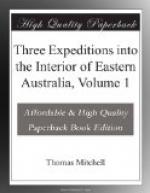The party moved to the former encampment at Bullabalakit. In passing near the place where we set up our tents on quitting the canvas boats, I sought my buried specimens of rocks, and found that, for once, I had been able to hide so that the natives could not find. The treasure however consisted only of stones. My notes addressed to Mr. Finch, which I had hidden in trees as we advanced, never escaped their notice, neither had the provisions left for the use of my unfortunate courier Bombelli at the camp we now again occupied been suffered to remain where we had cautiously buried them. All the planks of sawn timber left at our old saw-pit had been collected in a heap and partly burnt.
From the hill over the camp the view of the horizon was at length unobscured by smoke, and I found it possible to connect the distant points of the Nundewar range, with those then between us and the colony. Many hills which I had not before seen to the eastward were also visible. A heavy thundershower fell in the afternoon, and it was accompanied by a violent gale of wind which blew down Mr. White’s tent, and very materially injured mine.
TWO STRANGERS ON HORSEBACK.
February 26.
The party continued towards that portion of the Namoi at which we first arrived on advancing into those desolate regions, and we passed our old encampment beside The Barber’s stockyard near Tangulda. After travelling about eight miles we met Mr. Brown of Wallamoul and his stockman on horseback. They had followed our track thus far on the information they had received from the native, Mr. Brown, and were proceeding to examine The Barber’s stockyard. They informed us that our native guide confessed to them that his dread of the savage natives had induced him to return.
The men caught several large cod (Peel’s perch) one of which weighed 13 pounds. The river remained unswollen.
February 27.
As we continued our homeward journey Mr. Brown overtook us. He had found various brands of his cattle on portions of hide about the stock-yard. He assured me I should find no water at my old encampment where I intended again to halt, for that he had passed the previous night there without water. I however had the satisfaction to find as much as ever on the rocky bed of the watercourse where it is not so liable to be absorbed.
ASCEND MOUNT WARROGA.
Having arrived early at this spot I again ascended the range, and proceeded along its crests to one of the highest summits, named Warroga. From this point I could at length recognise Mount Murulla, Oxley’s Pic, Moan, and other pinnacles of the Liverpool range, and with which I now connected my last station upon the Namoi. From Ydire, a hill nearer the camp, I also obtained, in returning, some observations, and one angle of great value with Mount Forbes, much required for the purpose of mapping the country we had explored. On the side of Warroga, we saw a very large black wallaroo which sat looking at us with apparent curiosity.




